Analyzing Contractual Obligations and Exceptions in Payment Agreements
VerifiedAdded on 2020/05/16
|8
|1808
|88
AI Summary
The assignment focuses on the legal framework governing contractual obligations in payment disputes, highlighting key case laws like Pinnel's Case and the doctrine of promissory estoppel. Through an analysis of specific cases, it explores the concept of consideration, its exceptions, and how these principles are applied to resolve conflicts over agreed payments. The discussion includes a detailed examination of scenarios where partial payments and promises affect contractual rights, emphasizing the balance between strict legal rules and equitable considerations.
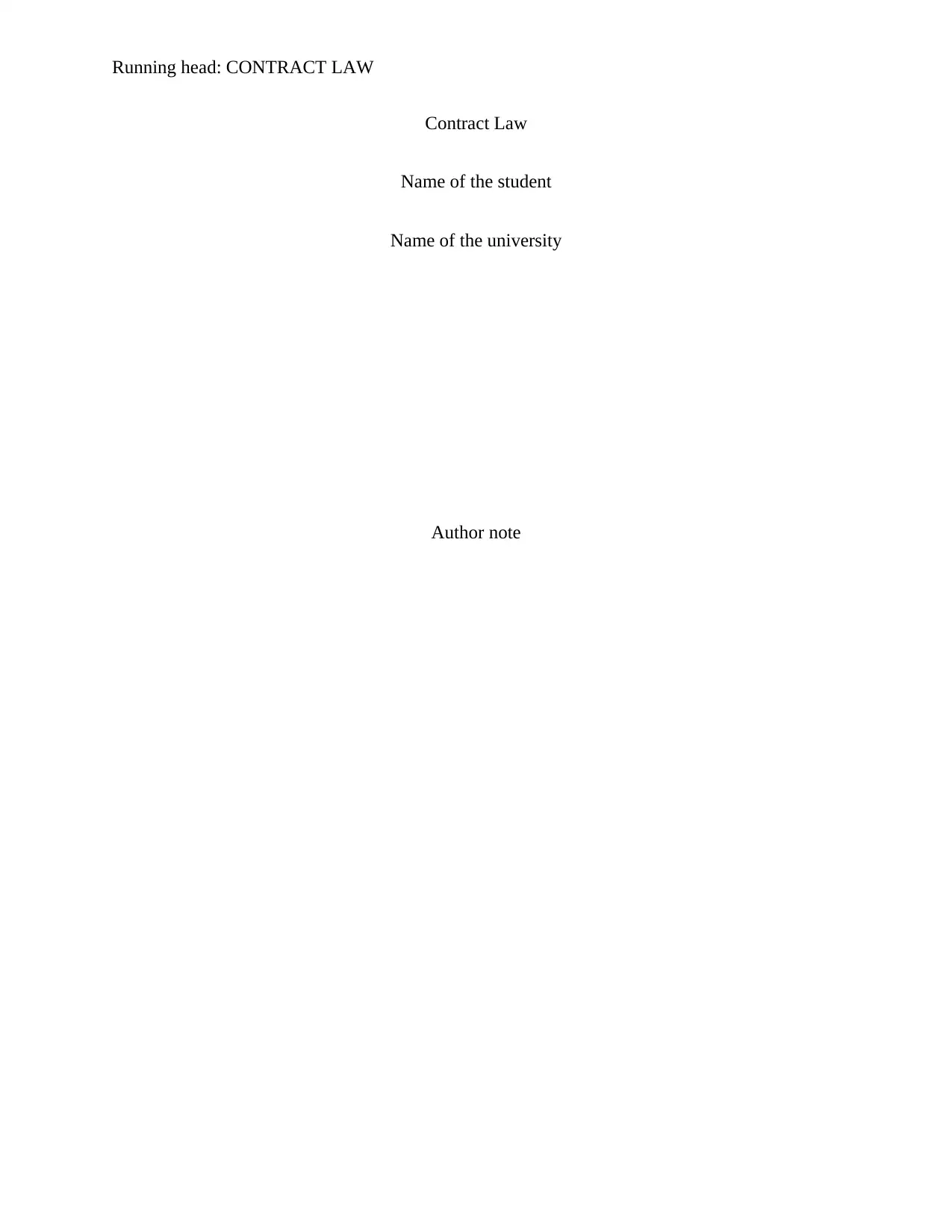
Running head: CONTRACT LAW
Contract Law
Name of the student
Name of the university
Author note
Contract Law
Name of the student
Name of the university
Author note
Paraphrase This Document
Need a fresh take? Get an instant paraphrase of this document with our AI Paraphraser
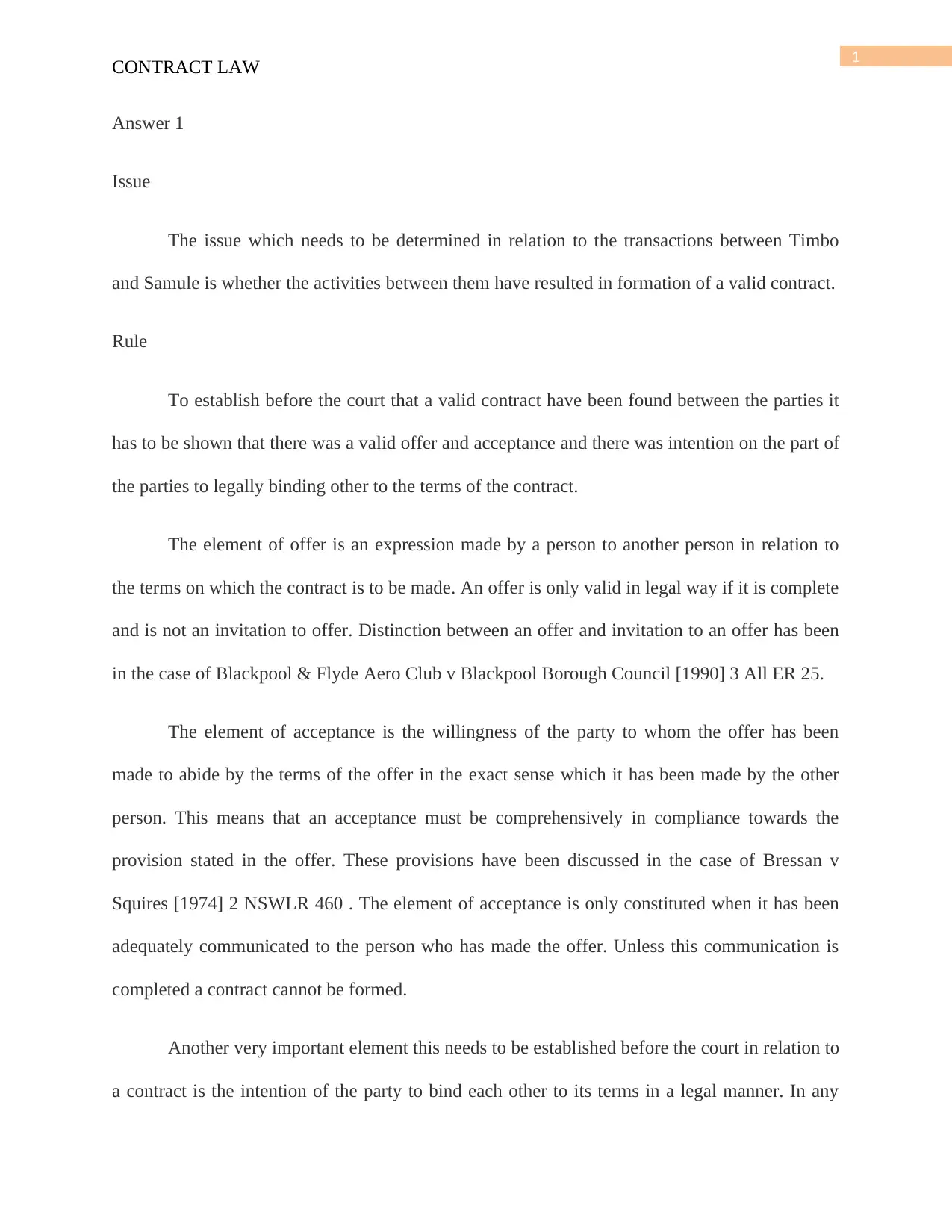
1
CONTRACT LAW
Answer 1
Issue
The issue which needs to be determined in relation to the transactions between Timbo
and Samule is whether the activities between them have resulted in formation of a valid contract.
Rule
To establish before the court that a valid contract have been found between the parties it
has to be shown that there was a valid offer and acceptance and there was intention on the part of
the parties to legally binding other to the terms of the contract.
The element of offer is an expression made by a person to another person in relation to
the terms on which the contract is to be made. An offer is only valid in legal way if it is complete
and is not an invitation to offer. Distinction between an offer and invitation to an offer has been
in the case of Blackpool & Flyde Aero Club v Blackpool Borough Council [1990] 3 All ER 25.
The element of acceptance is the willingness of the party to whom the offer has been
made to abide by the terms of the offer in the exact sense which it has been made by the other
person. This means that an acceptance must be comprehensively in compliance towards the
provision stated in the offer. These provisions have been discussed in the case of Bressan v
Squires [1974] 2 NSWLR 460 . The element of acceptance is only constituted when it has been
adequately communicated to the person who has made the offer. Unless this communication is
completed a contract cannot be formed.
Another very important element this needs to be established before the court in relation to
a contract is the intention of the party to bind each other to its terms in a legal manner. In any
CONTRACT LAW
Answer 1
Issue
The issue which needs to be determined in relation to the transactions between Timbo
and Samule is whether the activities between them have resulted in formation of a valid contract.
Rule
To establish before the court that a valid contract have been found between the parties it
has to be shown that there was a valid offer and acceptance and there was intention on the part of
the parties to legally binding other to the terms of the contract.
The element of offer is an expression made by a person to another person in relation to
the terms on which the contract is to be made. An offer is only valid in legal way if it is complete
and is not an invitation to offer. Distinction between an offer and invitation to an offer has been
in the case of Blackpool & Flyde Aero Club v Blackpool Borough Council [1990] 3 All ER 25.
The element of acceptance is the willingness of the party to whom the offer has been
made to abide by the terms of the offer in the exact sense which it has been made by the other
person. This means that an acceptance must be comprehensively in compliance towards the
provision stated in the offer. These provisions have been discussed in the case of Bressan v
Squires [1974] 2 NSWLR 460 . The element of acceptance is only constituted when it has been
adequately communicated to the person who has made the offer. Unless this communication is
completed a contract cannot be formed.
Another very important element this needs to be established before the court in relation to
a contract is the intention of the party to bind each other to its terms in a legal manner. In any
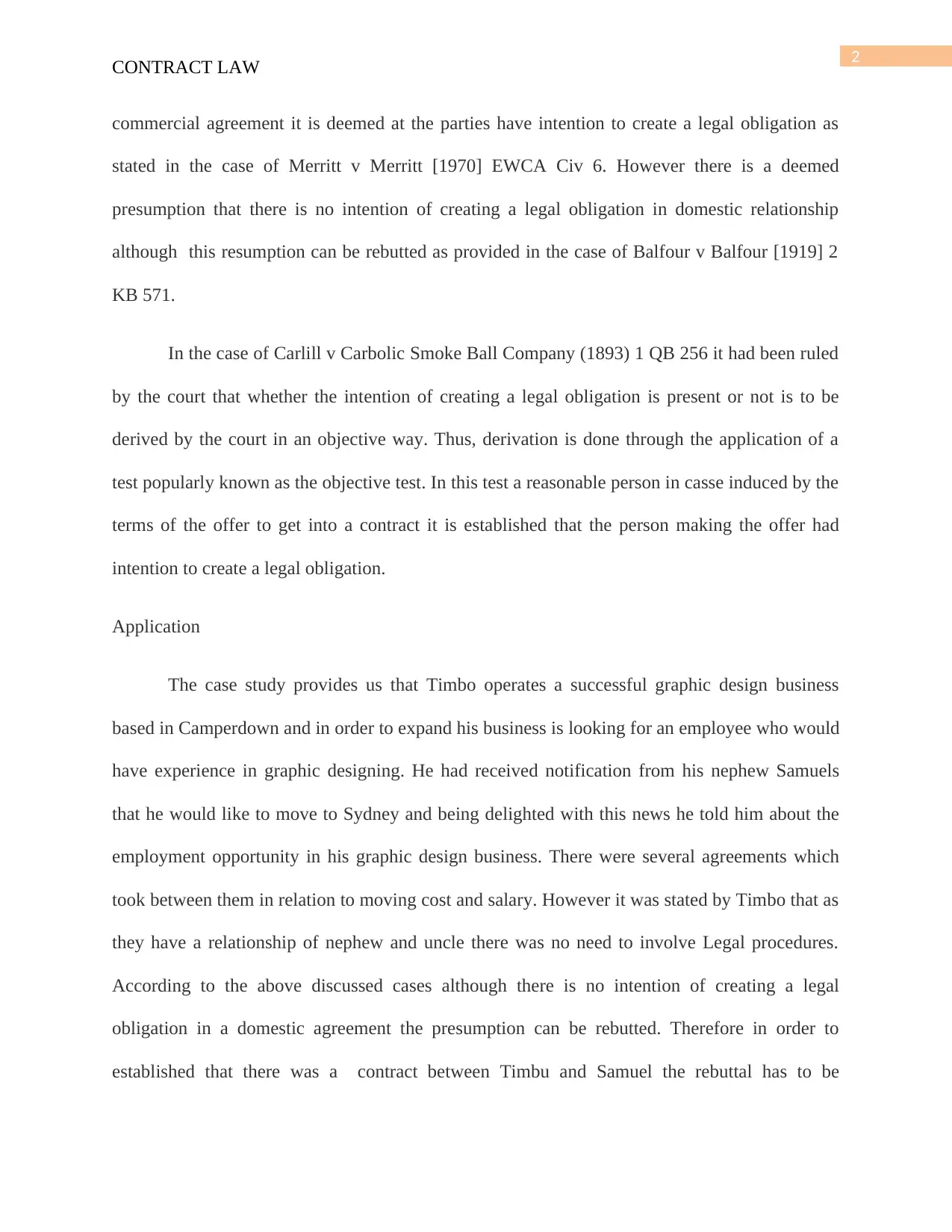
2
CONTRACT LAW
commercial agreement it is deemed at the parties have intention to create a legal obligation as
stated in the case of Merritt v Merritt [1970] EWCA Civ 6. However there is a deemed
presumption that there is no intention of creating a legal obligation in domestic relationship
although this resumption can be rebutted as provided in the case of Balfour v Balfour [1919] 2
KB 571.
In the case of Carlill v Carbolic Smoke Ball Company (1893) 1 QB 256 it had been ruled
by the court that whether the intention of creating a legal obligation is present or not is to be
derived by the court in an objective way. Thus, derivation is done through the application of a
test popularly known as the objective test. In this test a reasonable person in casse induced by the
terms of the offer to get into a contract it is established that the person making the offer had
intention to create a legal obligation.
Application
The case study provides us that Timbo operates a successful graphic design business
based in Camperdown and in order to expand his business is looking for an employee who would
have experience in graphic designing. He had received notification from his nephew Samuels
that he would like to move to Sydney and being delighted with this news he told him about the
employment opportunity in his graphic design business. There were several agreements which
took between them in relation to moving cost and salary. However it was stated by Timbo that as
they have a relationship of nephew and uncle there was no need to involve Legal procedures.
According to the above discussed cases although there is no intention of creating a legal
obligation in a domestic agreement the presumption can be rebutted. Therefore in order to
established that there was a contract between Timbu and Samuel the rebuttal has to be
CONTRACT LAW
commercial agreement it is deemed at the parties have intention to create a legal obligation as
stated in the case of Merritt v Merritt [1970] EWCA Civ 6. However there is a deemed
presumption that there is no intention of creating a legal obligation in domestic relationship
although this resumption can be rebutted as provided in the case of Balfour v Balfour [1919] 2
KB 571.
In the case of Carlill v Carbolic Smoke Ball Company (1893) 1 QB 256 it had been ruled
by the court that whether the intention of creating a legal obligation is present or not is to be
derived by the court in an objective way. Thus, derivation is done through the application of a
test popularly known as the objective test. In this test a reasonable person in casse induced by the
terms of the offer to get into a contract it is established that the person making the offer had
intention to create a legal obligation.
Application
The case study provides us that Timbo operates a successful graphic design business
based in Camperdown and in order to expand his business is looking for an employee who would
have experience in graphic designing. He had received notification from his nephew Samuels
that he would like to move to Sydney and being delighted with this news he told him about the
employment opportunity in his graphic design business. There were several agreements which
took between them in relation to moving cost and salary. However it was stated by Timbo that as
they have a relationship of nephew and uncle there was no need to involve Legal procedures.
According to the above discussed cases although there is no intention of creating a legal
obligation in a domestic agreement the presumption can be rebutted. Therefore in order to
established that there was a contract between Timbu and Samuel the rebuttal has to be
⊘ This is a preview!⊘
Do you want full access?
Subscribe today to unlock all pages.

Trusted by 1+ million students worldwide
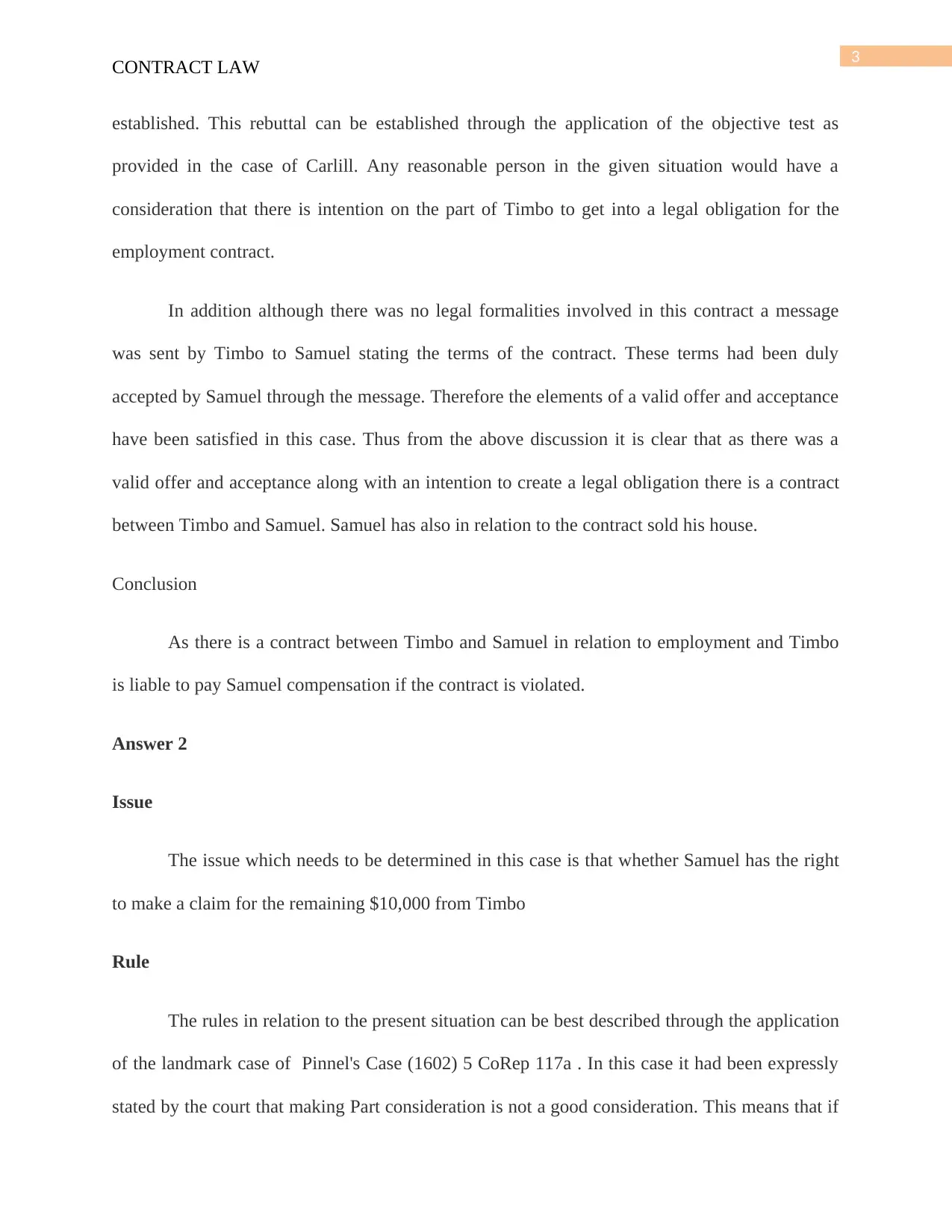
3
CONTRACT LAW
established. This rebuttal can be established through the application of the objective test as
provided in the case of Carlill. Any reasonable person in the given situation would have a
consideration that there is intention on the part of Timbo to get into a legal obligation for the
employment contract.
In addition although there was no legal formalities involved in this contract a message
was sent by Timbo to Samuel stating the terms of the contract. These terms had been duly
accepted by Samuel through the message. Therefore the elements of a valid offer and acceptance
have been satisfied in this case. Thus from the above discussion it is clear that as there was a
valid offer and acceptance along with an intention to create a legal obligation there is a contract
between Timbo and Samuel. Samuel has also in relation to the contract sold his house.
Conclusion
As there is a contract between Timbo and Samuel in relation to employment and Timbo
is liable to pay Samuel compensation if the contract is violated.
Answer 2
Issue
The issue which needs to be determined in this case is that whether Samuel has the right
to make a claim for the remaining $10,000 from Timbo
Rule
The rules in relation to the present situation can be best described through the application
of the landmark case of Pinnel's Case (1602) 5 CoRep 117a . In this case it had been expressly
stated by the court that making Part consideration is not a good consideration. This means that if
CONTRACT LAW
established. This rebuttal can be established through the application of the objective test as
provided in the case of Carlill. Any reasonable person in the given situation would have a
consideration that there is intention on the part of Timbo to get into a legal obligation for the
employment contract.
In addition although there was no legal formalities involved in this contract a message
was sent by Timbo to Samuel stating the terms of the contract. These terms had been duly
accepted by Samuel through the message. Therefore the elements of a valid offer and acceptance
have been satisfied in this case. Thus from the above discussion it is clear that as there was a
valid offer and acceptance along with an intention to create a legal obligation there is a contract
between Timbo and Samuel. Samuel has also in relation to the contract sold his house.
Conclusion
As there is a contract between Timbo and Samuel in relation to employment and Timbo
is liable to pay Samuel compensation if the contract is violated.
Answer 2
Issue
The issue which needs to be determined in this case is that whether Samuel has the right
to make a claim for the remaining $10,000 from Timbo
Rule
The rules in relation to the present situation can be best described through the application
of the landmark case of Pinnel's Case (1602) 5 CoRep 117a . In this case it had been expressly
stated by the court that making Part consideration is not a good consideration. This means that if
Paraphrase This Document
Need a fresh take? Get an instant paraphrase of this document with our AI Paraphraser
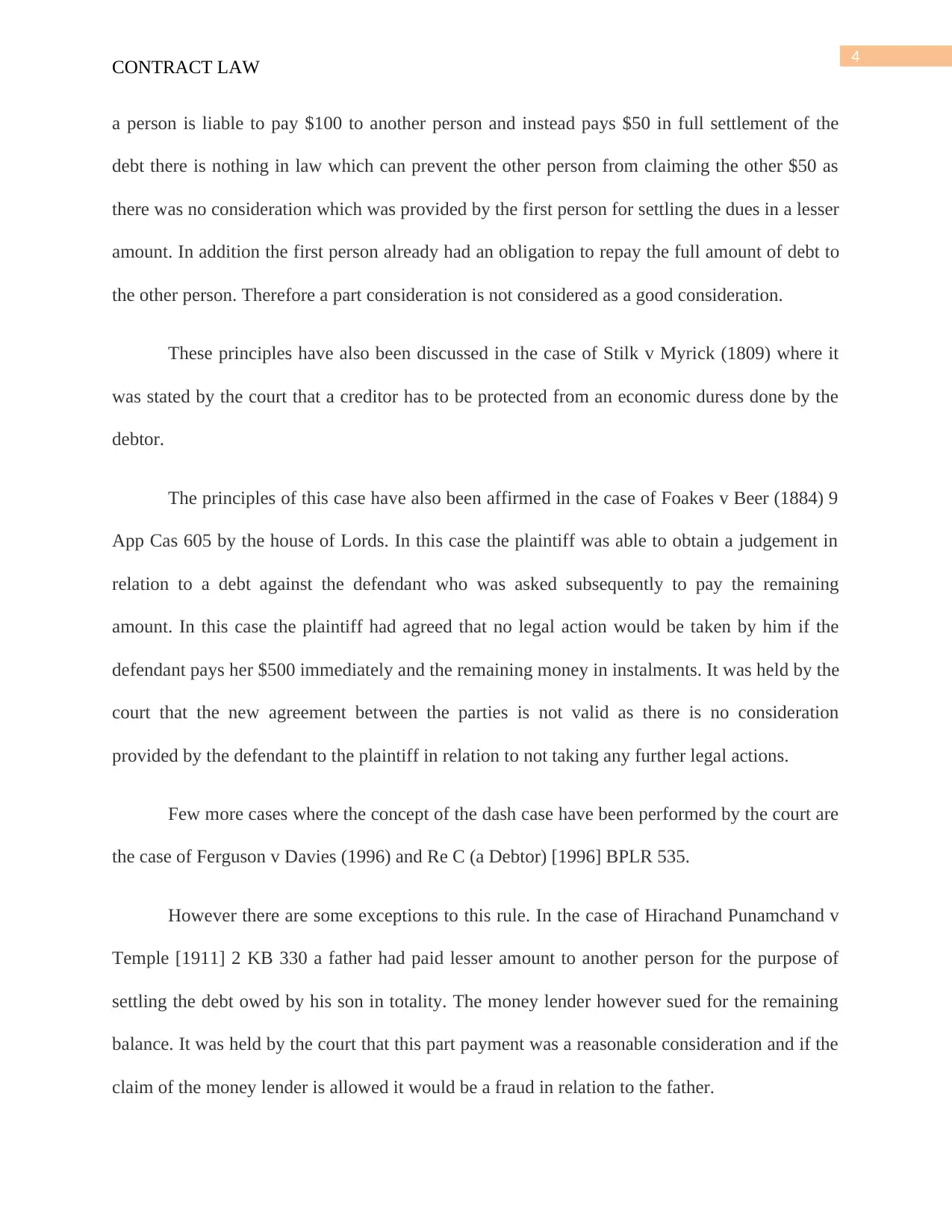
4
CONTRACT LAW
a person is liable to pay $100 to another person and instead pays $50 in full settlement of the
debt there is nothing in law which can prevent the other person from claiming the other $50 as
there was no consideration which was provided by the first person for settling the dues in a lesser
amount. In addition the first person already had an obligation to repay the full amount of debt to
the other person. Therefore a part consideration is not considered as a good consideration.
These principles have also been discussed in the case of Stilk v Myrick (1809) where it
was stated by the court that a creditor has to be protected from an economic duress done by the
debtor.
The principles of this case have also been affirmed in the case of Foakes v Beer (1884) 9
App Cas 605 by the house of Lords. In this case the plaintiff was able to obtain a judgement in
relation to a debt against the defendant who was asked subsequently to pay the remaining
amount. In this case the plaintiff had agreed that no legal action would be taken by him if the
defendant pays her $500 immediately and the remaining money in instalments. It was held by the
court that the new agreement between the parties is not valid as there is no consideration
provided by the defendant to the plaintiff in relation to not taking any further legal actions.
Few more cases where the concept of the dash case have been performed by the court are
the case of Ferguson v Davies (1996) and Re C (a Debtor) [1996] BPLR 535.
However there are some exceptions to this rule. In the case of Hirachand Punamchand v
Temple [1911] 2 KB 330 a father had paid lesser amount to another person for the purpose of
settling the debt owed by his son in totality. The money lender however sued for the remaining
balance. It was held by the court that this part payment was a reasonable consideration and if the
claim of the money lender is allowed it would be a fraud in relation to the father.
CONTRACT LAW
a person is liable to pay $100 to another person and instead pays $50 in full settlement of the
debt there is nothing in law which can prevent the other person from claiming the other $50 as
there was no consideration which was provided by the first person for settling the dues in a lesser
amount. In addition the first person already had an obligation to repay the full amount of debt to
the other person. Therefore a part consideration is not considered as a good consideration.
These principles have also been discussed in the case of Stilk v Myrick (1809) where it
was stated by the court that a creditor has to be protected from an economic duress done by the
debtor.
The principles of this case have also been affirmed in the case of Foakes v Beer (1884) 9
App Cas 605 by the house of Lords. In this case the plaintiff was able to obtain a judgement in
relation to a debt against the defendant who was asked subsequently to pay the remaining
amount. In this case the plaintiff had agreed that no legal action would be taken by him if the
defendant pays her $500 immediately and the remaining money in instalments. It was held by the
court that the new agreement between the parties is not valid as there is no consideration
provided by the defendant to the plaintiff in relation to not taking any further legal actions.
Few more cases where the concept of the dash case have been performed by the court are
the case of Ferguson v Davies (1996) and Re C (a Debtor) [1996] BPLR 535.
However there are some exceptions to this rule. In the case of Hirachand Punamchand v
Temple [1911] 2 KB 330 a father had paid lesser amount to another person for the purpose of
settling the debt owed by his son in totality. The money lender however sued for the remaining
balance. It was held by the court that this part payment was a reasonable consideration and if the
claim of the money lender is allowed it would be a fraud in relation to the father.
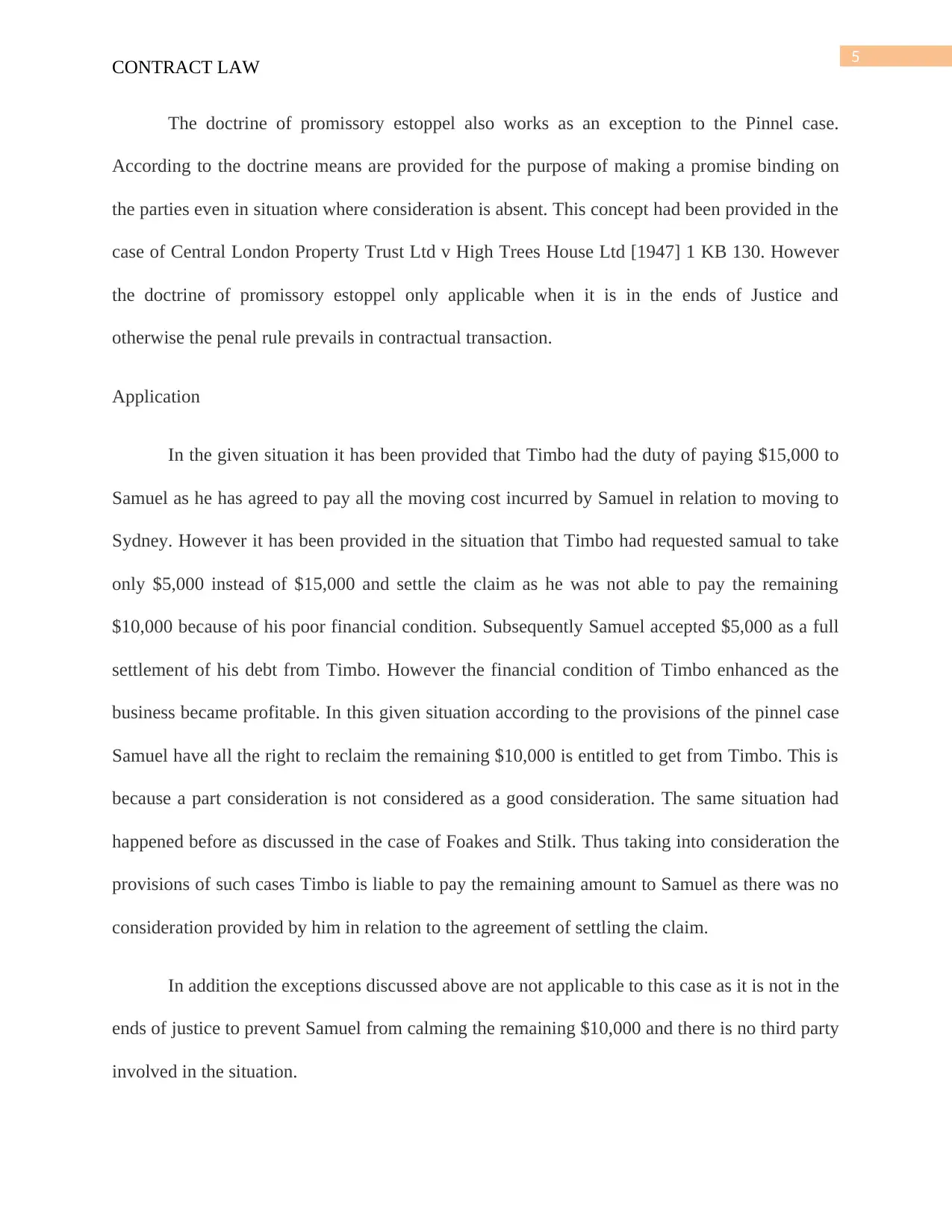
5
CONTRACT LAW
The doctrine of promissory estoppel also works as an exception to the Pinnel case.
According to the doctrine means are provided for the purpose of making a promise binding on
the parties even in situation where consideration is absent. This concept had been provided in the
case of Central London Property Trust Ltd v High Trees House Ltd [1947] 1 KB 130. However
the doctrine of promissory estoppel only applicable when it is in the ends of Justice and
otherwise the penal rule prevails in contractual transaction.
Application
In the given situation it has been provided that Timbo had the duty of paying $15,000 to
Samuel as he has agreed to pay all the moving cost incurred by Samuel in relation to moving to
Sydney. However it has been provided in the situation that Timbo had requested samual to take
only $5,000 instead of $15,000 and settle the claim as he was not able to pay the remaining
$10,000 because of his poor financial condition. Subsequently Samuel accepted $5,000 as a full
settlement of his debt from Timbo. However the financial condition of Timbo enhanced as the
business became profitable. In this given situation according to the provisions of the pinnel case
Samuel have all the right to reclaim the remaining $10,000 is entitled to get from Timbo. This is
because a part consideration is not considered as a good consideration. The same situation had
happened before as discussed in the case of Foakes and Stilk. Thus taking into consideration the
provisions of such cases Timbo is liable to pay the remaining amount to Samuel as there was no
consideration provided by him in relation to the agreement of settling the claim.
In addition the exceptions discussed above are not applicable to this case as it is not in the
ends of justice to prevent Samuel from calming the remaining $10,000 and there is no third party
involved in the situation.
CONTRACT LAW
The doctrine of promissory estoppel also works as an exception to the Pinnel case.
According to the doctrine means are provided for the purpose of making a promise binding on
the parties even in situation where consideration is absent. This concept had been provided in the
case of Central London Property Trust Ltd v High Trees House Ltd [1947] 1 KB 130. However
the doctrine of promissory estoppel only applicable when it is in the ends of Justice and
otherwise the penal rule prevails in contractual transaction.
Application
In the given situation it has been provided that Timbo had the duty of paying $15,000 to
Samuel as he has agreed to pay all the moving cost incurred by Samuel in relation to moving to
Sydney. However it has been provided in the situation that Timbo had requested samual to take
only $5,000 instead of $15,000 and settle the claim as he was not able to pay the remaining
$10,000 because of his poor financial condition. Subsequently Samuel accepted $5,000 as a full
settlement of his debt from Timbo. However the financial condition of Timbo enhanced as the
business became profitable. In this given situation according to the provisions of the pinnel case
Samuel have all the right to reclaim the remaining $10,000 is entitled to get from Timbo. This is
because a part consideration is not considered as a good consideration. The same situation had
happened before as discussed in the case of Foakes and Stilk. Thus taking into consideration the
provisions of such cases Timbo is liable to pay the remaining amount to Samuel as there was no
consideration provided by him in relation to the agreement of settling the claim.
In addition the exceptions discussed above are not applicable to this case as it is not in the
ends of justice to prevent Samuel from calming the remaining $10,000 and there is no third party
involved in the situation.
⊘ This is a preview!⊘
Do you want full access?
Subscribe today to unlock all pages.

Trusted by 1+ million students worldwide

6
CONTRACT LAW
Conclusion
Samuel has the right to claim $10,000 from Timbo
CONTRACT LAW
Conclusion
Samuel has the right to claim $10,000 from Timbo
Paraphrase This Document
Need a fresh take? Get an instant paraphrase of this document with our AI Paraphraser
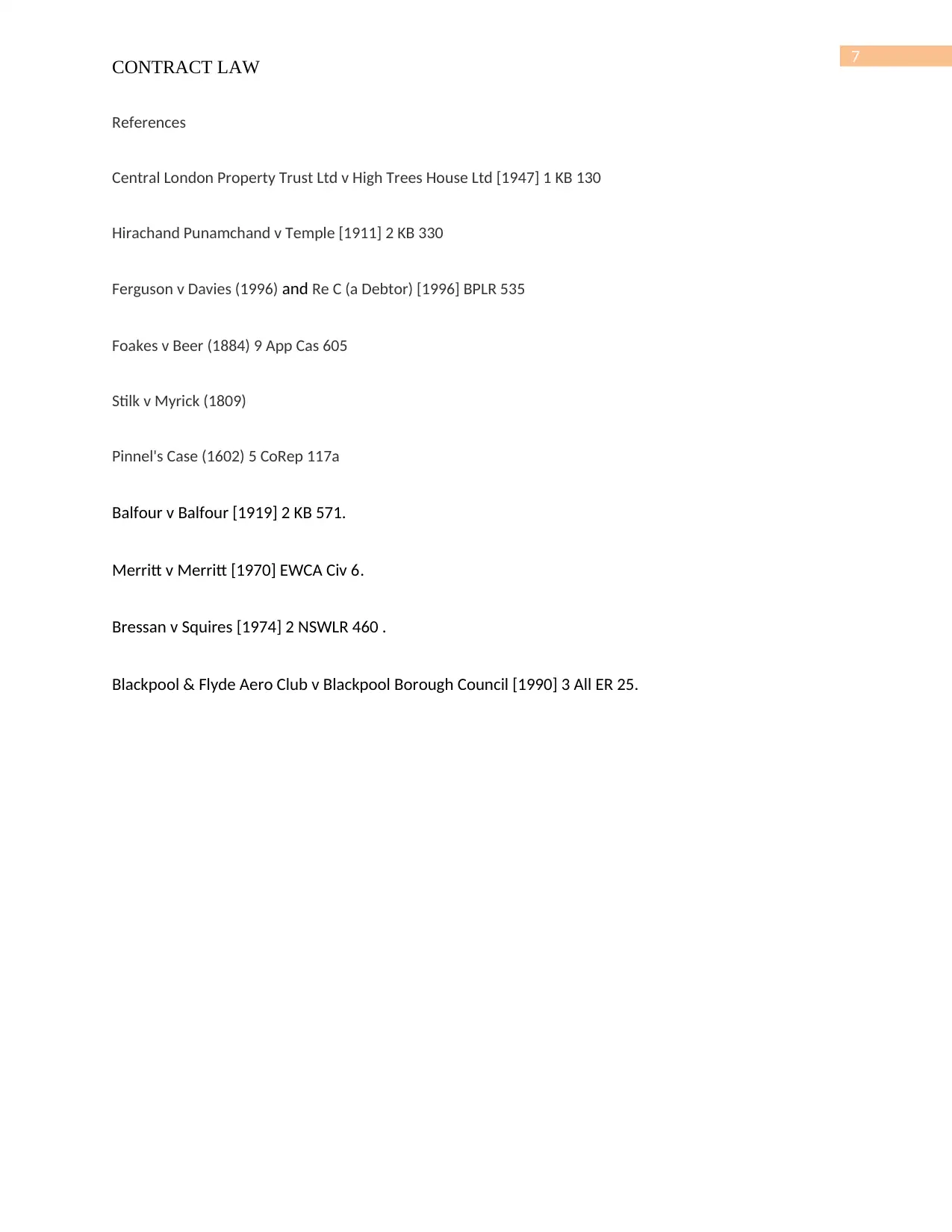
7
CONTRACT LAW
References
Central London Property Trust Ltd v High Trees House Ltd [1947] 1 KB 130
Hirachand Punamchand v Temple [1911] 2 KB 330
Ferguson v Davies (1996) and Re C (a Debtor) [1996] BPLR 535
Foakes v Beer (1884) 9 App Cas 605
Stilk v Myrick (1809)
Pinnel's Case (1602) 5 CoRep 117a
Balfour v Balfour [1919] 2 KB 571.
Merritt v Merritt [1970] EWCA Civ 6.
Bressan v Squires [1974] 2 NSWLR 460 .
Blackpool & Flyde Aero Club v Blackpool Borough Council [1990] 3 All ER 25.
CONTRACT LAW
References
Central London Property Trust Ltd v High Trees House Ltd [1947] 1 KB 130
Hirachand Punamchand v Temple [1911] 2 KB 330
Ferguson v Davies (1996) and Re C (a Debtor) [1996] BPLR 535
Foakes v Beer (1884) 9 App Cas 605
Stilk v Myrick (1809)
Pinnel's Case (1602) 5 CoRep 117a
Balfour v Balfour [1919] 2 KB 571.
Merritt v Merritt [1970] EWCA Civ 6.
Bressan v Squires [1974] 2 NSWLR 460 .
Blackpool & Flyde Aero Club v Blackpool Borough Council [1990] 3 All ER 25.
1 out of 8
Related Documents
Your All-in-One AI-Powered Toolkit for Academic Success.
+13062052269
info@desklib.com
Available 24*7 on WhatsApp / Email
![[object Object]](/_next/static/media/star-bottom.7253800d.svg)
Unlock your academic potential
Copyright © 2020–2025 A2Z Services. All Rights Reserved. Developed and managed by ZUCOL.




